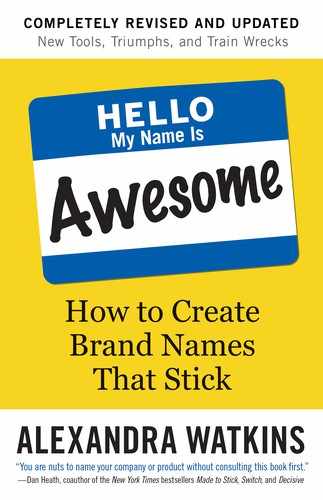INTRODUCTION
“Hello, my name is Alexandra.” Sounds simple enough. But strangers often butcher my name. Alexandria. Alexia. Alexa. And, much to my annoyance, the manly version, Alexander.
What about your first and last name? Are they tricky to spell? Difficult to pronounce? Hard to remember? This trifecta of trouble is rampant among brand names: Xobni, Sur La Table, Iams, Flickr, Saucony, and Eukanuba. Those are just a handful of the head-scratchers consumers struggle with. But unlike the name you were born with or married into, these companies chose to start out with names that are easily bungled. At the time, they may have thought they were being clever. But even after being in business for years, they find themselves having to explain the name. How to spell it. How to pronounce it. What it means. Anytime you have to make excuses for your name, you’re apologizing for it. And when you apologize for your name, your brand is devalued.
I’m going to prevent you from making any of these mistakes.
Amazon, Coca-Cola, Disney, Frito-Lay, Google, Xerox, and other big brands hire my firm because they have discovered what I have known for years—names that resonate most with consumers are delightfully unexpected yet easy to understand. We instantly “get” them, like a snappy punch line. No one wants to feel clueless. (Have you figured out what Xobni means yet?)
I’ve filled every page of this book with practical, firsthand knowledge. There are no wasted words. You won’t find any junk science, branding jargon, or linguistic mumbo jumbo. And I haven’t included the etymology of famous brand names. Sure, those stories are interesting. But this is a how-to guide, not a history book.
My techniques for coming up with memorable brand names can be learned by anyone. Even the most uptight actuary can unleash their inner creative beast to come up with terrific names that everyone can spell, pronounce, and understand. I don’t believe in creating names that are unfamiliar, unrecognizable, or unintelligible. Who cares that the name Hiranyagarbha means “cosmic intelligence” in ancient Sanskrit?
The most powerful names get noticed, get buzz, and get sales because they connect with consumers on an emotional level, making us feel good. Traditional naming firms have yet to figure this out. This is how I was able to make a name for myself. When I started out, I worked as a professional namer for big branding firms like Landor and Interbrand. It baffled me that instead of hiring conceptual writers from advertising to create names, they recruited people from academia. What can a degree in theoretical linguistics possibly teach anyone about making emotional connections with consumers?
You will find no pedagogical examples in this book, just dozens of true stories about real names. The good, the bad, and the “so bad I gave them an award.” I am not afraid to name names.
I’ll break down the brainstorming process by walking you through how to come up with dozens of creative name ideas using my most trusted tools and treasure troves.
Before we jump in to brainstorming name ideas, you’ll learn how to objectively evaluate names using the SMILE & SCRATCH test, a checklist based on my philosophy: A name should make you smile instead of scratch your head.
SMILE: The 5 Qualities of a Super-Sticky Name
Suggestive—evokes something about your brand
Memorable—makes an association with the familiar
Imagery—aids memory through evocative visuals
Legs—lends itself to a theme for extended mileage
Emotional—moves people
SCRATCH: The 7 Deal Breakers
Spelling challenged—looks like a typo
Copycat—resembles competitors’ names
Restrictive—limits future growth
Annoying—seems forced, frustrates customers
Tame—feels flat, descriptive, uninspired
Curse of knowledge—speaks only to insiders
Hard to pronounce—confuses and distances customers
This filter is a no-brainer, right? Yet you’d be surprised how many brand names fail this test. (How does the name Xobni do?) Everything in this book is that clear. And by the time you finish the last chapter, you will have the knowledge you need to create awesome names on your own.
Some of my colleagues think I’m crazy for sharing my secret sauce. They think that I may be cannibalizing my business by showing “amateurs” how to do what I get paid the big bucks for. I can assure you that since the book was originally published, it has not put me out of the name game. But it has put me out of my misery by helping prevent bad names from happening to good brands.
Alexandra Watkins
P.S. If you’re still trying to decipher Xobni, it’s “inbox” spelled backward. Don’t worry; no one else figured it out either.
